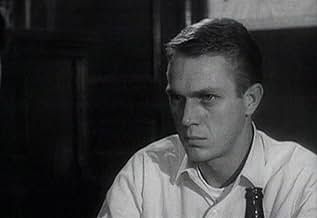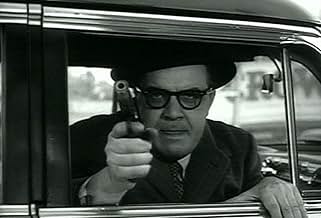CALIFICACIÓN DE IMDb
5.8/10
1.8 k
TU CALIFICACIÓN
Agrega una trama en tu idiomaA gang's plans for a St. Louis bank robbery are complicated when the sister of one of the thieves starts voicing her well-founded suspicions.A gang's plans for a St. Louis bank robbery are complicated when the sister of one of the thieves starts voicing her well-founded suspicions.A gang's plans for a St. Louis bank robbery are complicated when the sister of one of the thieves starts voicing her well-founded suspicions.
- Dirección
- Guionista
- Elenco
- Dirección
- Guionista
- Todo el elenco y el equipo
- Producción, taquilla y más en IMDbPro
Opiniones destacadas
This too little known noir work was filmed five years after the events of which it treats, and employs the settings where it occurred, Southwest Bank and its environs in St. Louis, while carefully utilizing within its cast the actual policemen, bank customers and area residents who were involved in the affair, all of which produce somewhat of a documentary impression. Three ex-convicts are joined by a college expellee, George Fowler (Steve McQueen during his Method period), creating an abruptly formed criminal quartet, with Fowler, assigned as wheel man for his first organized illegal endeavour, and we watch them as the robbery is carefully planned by the group's leader, John Egan (Crahan Denton) amid an assortment of simmering frustrations and jealousies which infest the men. Producer Charles Guggenheim also directs, with assistance from John Stix, and the duo focus upon obtaining a naturalistic setting from the interesting script, which is very intense in feeling, with rather harsh dialogue, resulting in a dark film, at the heart of which is an old fashioned shootout where tactics are forgotten by both sides.
A very realistic heist film that is based on an actual crime and uses as a location the bank where the robbery took place.
The makers of this film were very professional and did a good job. The only downside to the movie is that it is so sombre; the characters aren't charismatic, witty, or cheerful, and they aren't in the habit of saying things like "Do you feel lucky?" or "Make my day." (On the other hand, that fact adds to the realism.)
Steve McQueen performs well, and he's not trying to be Marlon Brando. His character is a young, inexperienced man just out of college who's not too sure of himself and who is trying not to become a habitual criminal.
Since the film is in the public domain, a high-resolution copy can be downloaded here: http://www.archive.org/details/Saint_Louis_Bank_Robbery
The makers of this film were very professional and did a good job. The only downside to the movie is that it is so sombre; the characters aren't charismatic, witty, or cheerful, and they aren't in the habit of saying things like "Do you feel lucky?" or "Make my day." (On the other hand, that fact adds to the realism.)
Steve McQueen performs well, and he's not trying to be Marlon Brando. His character is a young, inexperienced man just out of college who's not too sure of himself and who is trying not to become a habitual criminal.
Since the film is in the public domain, a high-resolution copy can be downloaded here: http://www.archive.org/details/Saint_Louis_Bank_Robbery
Let me begin by pointing out that IMDb makes a mistake when it lists Nell Roberts as "Woman in Bar Talking to George." The woman in the bar is George's girlfriend Ann, played by Molly McCarthy. Nell Roberts is the Salvation Army woman who appears in three places in the film but who speaks only at the end when she tells a cop, "Don't go in. They're robbing the bank." I speak from authority as the great-nephew of Nell Roberts, my grandmother's sister, who was active in community theater in St. Louis in the 1950s, and who also had a bit role (as an old woman who answers the door) in the film, "Hoodlum Priest" (starring Don Murray), which was also made in St. Louis. We always knew her as "Aunt Nelly," so I guess "Nell" was her stage name.
In any case, "The Great St. Louis Bank Robbery" is an interesting little movie -- though there really is nothing "great" about it. The noir approach fits the story line perfectly, but the execution strikes me as stiff and amateurish, especially in the acting and the editing. McQueen was doing what he could to be Brando, but Brando he wasn't. The three other members of the gang and the girlfriend have various small strengths as actors to commend them, but they wouldn't have been enough for professional survival today. The plethora of extras and bit players must have saved the producers some dinero, and they do give the film a certain documentary and amateur-theatrical charm, but their performances (including Aunt Nelly's) are of a type to make the viewer uncomfortable in the expectation of an embarrassing gaff. The homosexual subtext (mentioned by other reviewers) is certainly not imaginary. In fact, the things that make this movie most worth watching are, first, that homosexuality is included as a theme at all -- it was not necessary to the film's integrity unless the producers were aiming at some politically incorrect social commentary or had a personal ax to grind -- and, second, that the gay relationships had to be coded to make the finished work acceptable to the public in the late 1950s.
But I did enjoy the look of the cars and the streets of St. Louis (a la New York in "The Naked City") before the rapid urban disintegration that overtook it shortly afterwards, and from which it has still not recovered. The was the REAL "St. Louis Bank Robbery."
In any case, "The Great St. Louis Bank Robbery" is an interesting little movie -- though there really is nothing "great" about it. The noir approach fits the story line perfectly, but the execution strikes me as stiff and amateurish, especially in the acting and the editing. McQueen was doing what he could to be Brando, but Brando he wasn't. The three other members of the gang and the girlfriend have various small strengths as actors to commend them, but they wouldn't have been enough for professional survival today. The plethora of extras and bit players must have saved the producers some dinero, and they do give the film a certain documentary and amateur-theatrical charm, but their performances (including Aunt Nelly's) are of a type to make the viewer uncomfortable in the expectation of an embarrassing gaff. The homosexual subtext (mentioned by other reviewers) is certainly not imaginary. In fact, the things that make this movie most worth watching are, first, that homosexuality is included as a theme at all -- it was not necessary to the film's integrity unless the producers were aiming at some politically incorrect social commentary or had a personal ax to grind -- and, second, that the gay relationships had to be coded to make the finished work acceptable to the public in the late 1950s.
But I did enjoy the look of the cars and the streets of St. Louis (a la New York in "The Naked City") before the rapid urban disintegration that overtook it shortly afterwards, and from which it has still not recovered. The was the REAL "St. Louis Bank Robbery."
This film, as much the story of the personal lives of the robbers as of the heist, features terrific performances, a highly original script for the genre, and exceptional visuals and direction. Each of the would-be bandits is emotionally damaged in some way and the film reveals their individual quirky weaknesses with raw style. In one such sequence, Gino (David Clarke) is shaving and becomes intensely disturbed and claustrophobic when his roommate and fellow member of the gang (Steve McQueen) unexpectedly closes the bathroom door, a scene which stylistically seems to anticipate "Psycho", released in the following year. The look of late 50's St. Louis, the bandits' clothes and hats, the cars they drive, all provide a fascinating edge to this true story of a bank robbery, and one of the last great Noir films.
This 1959 film, co-directed by Charles Guggenheim and John Stix, is for all its weaknesses a most commendable attempt to photograph a standard heist film in semi-documentary style. Shot on the locations in St. Louis where the actual robbery occurred, it almost succeeds. Unlike many earlier crime films in this genre, the screenplay by Richard Heffron makes no attempt to have us sympathize with the professional criminals. Few crime films of the era or before portrayed the common bank robber and his accomplices with such cold reality, going so far as to hint at the homosexual relationships that occur among hardened criminals who spent their lives incarcerated. The major weakness of the film is the time it spends attempting to establish a relationship between McQueen and the sister of one of the bank robbers. Molly McCarthy, physically believable and sympathetic, is not quite up to carrying off her admittedly complex role, particularly in comparison to the brilliance of the then 29-year-old Steve McQueen. McQueen received only $4,000 for his work, but he steals the picture, making the psychology of the young man beyond his depth who gets involved with a gang of professionals and cannot get out thoroughly believable. He is especially effective in the end of the film. The film is also helped by an original minimal score by Bernardo Segall, whose orchestration resembles that of European films of the same time. Guggenheim who had a talent for this sort of film later went on to direct many award-winning documentaries, leaving the crime film behind him. Too bad. He was after something here.
¿Sabías que…?
- TriviaThis story is based on a true incident that occurred in 1953. Many of the St. Louis Metropolitan Police officers and bank employees play themselves doing what they did during the actual robbery.
- ErroresWhen Ann writes on the bank window with her lipstick the message reads, "WARNING - YOU WILL BE ROBBED!" Later when we see a bank worker cleaning the message off the window not only is the handwriting different, the message is too: "WARNING - THIS BANK..."
- Citas
George Fowler: Look, Mr Egan, I don't know what Gino told you about me but I didn't come here to be a petty thief.
- ConexionesEdited into Robot Bride of Manos (2022)
- Bandas sonorasNight Train
By Bernardo Segall (as Bernardo Segáll) and Peter Udell
Selecciones populares
Inicia sesión para calificar y agrega a la lista de videos para obtener recomendaciones personalizadas
- How long is The St. Louis Bank Robbery?Con tecnología de Alexa
Detalles
- Fecha de lanzamiento
- País de origen
- Idioma
- También se conoce como
- The Great St. Louis Bank Robbery
- Locaciones de filmación
- Productora
- Ver más créditos de la compañía en IMDbPro
- Tiempo de ejecución1 hora 29 minutos
- Color
- Relación de aspecto
- 1.66 : 1
Contribuir a esta página
Sugiere una edición o agrega el contenido que falta

Principales brechas de datos
By what name was The St. Louis Bank Robbery (1959) officially released in India in English?
Responda
























